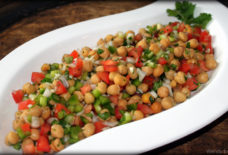SOURCE: HEALTHLINE
BY: RYAN RAMAN
Falafel is a dish of Middle Eastern origin that’s especially popular among vegetarians and vegans.
It consists of deep-fried patties that are made from a combination of chickpeas (or fava beans), herbs, spices, onion, and dough.
Falafel can be a stand-alone side dish, but it’s commonly served in a pita pocket, flatbread, or as part of an assortment of appetizers called a meze.
Although it’s quite popular and packed with healthy ingredients, many people wonder whether it’s truly a healthy dish.
This article reviews whether falafel is healthy and provides a nutritious recipe.
Falafel is packed with a variety of important nutrients.
A 3.5-ounce (100-gram) serving of 6 small patties of falafel contains the following nutrients (1Trusted Source):
- Calories: 333
- Protein: 13.3 grams
- Carbs: 31.8 grams
- Fat: 17.8 grams
- Fiber: 4.9 grams
- Vitamin B6: 94% of the Daily Value (DV)
- Manganese: 30% of the DV
- Copper: 29% of the DV
- Folate: 26% of the DV
- Magnesium: 20% of the DV
- Iron: 19% of the DV
- Phosphorus: 15% of the DV
- Zinc: 14% of the DV
- Riboflavin: 13% of the DV
- Potassium: 12% of the DV
- Thiamine: 12% of the DV
Falafel also contains small amounts of niacin, vitamin B5, calcium, and many other micronutrients.
That said, falafel is traditionally deep-fried in oil, so falafel purchased at restaurants can be high in fat and calories.
SUMMARYFalafel contains a variety of important nutrients, but it’s traditionally deep-fried in oil, which can make it high in fat and calories.
Falafel has several qualities that may benefit your health in various ways.
To start, it’s a good source of fiber and plant-based protein, two nutrients that work synergistically to help keep you full for longer throughout the day.
Both fiber and protein have been shown to reduce the production of hunger hormones, such as ghrelin, while increasing the production of fullness
hormones like cholecystokinin, glucagon-like peptide-1, and peptide YY (2Trusted Source, 3Trusted Source, 4Trusted Source).
Also, studies have shown that chickpea fiber may help manage blood sugar levels by slowing carb absorption. This promotes steady rises in blood sugar rather than spikes (5Trusted Source, 6Trusted Source).
Moreover, chickpea fiber has been linked to improved bowel health, as well as lowered risks of heart disease and colon cancer (7Trusted Source, 8Trusted Source, 9Trusted Source, 10Trusted Source).
Depending on what ingredients are added to falafel, they can be naturally gluten-free and dairy-free, making them a good option for most diets.
That said, falafel can have downsides, depending on how it’s prepared.
It’s typically deep-fried in oil, which significantly increases its calorie and fat content (11Trusted Source).
Studies consistently show that people who regularly consume deep-fried foods have a higher risk of obesity, heart disease, diabetes, and cancer (12Trusted Source, 13Trusted Source).
What’s more, some people may have allergies to ingredients that are either in or served with falafel, such as sesame seeds.
However, making your own falafel at home can minimize these downsides.
SUMMARYFalafel is high in many micronutrients and a good source of fiber and protein. As such, it may help curb your appetite, support healthy blood sugar, and lower your risk of chronic disease. Yet, it’s typically deep-fried in oil, which raises its fat and calorie content.
Falafel is easy to make at home with only a few ingredients.
Additionally, making your own falafel allows you to bake them rather than deep-fry them, which cuts back on excess oil, fat, and calories.
The following ingredients and ratios are used to make about 12 falafel:
- 1 15-ounce (425-gram) can of chickpeas, drained and rinsed
- 4 cloves of fresh garlic
- 1/2 cup (75 grams) of chopped onion
- 2 tablespoons of fresh, chopped parsley
- 1 tablespoon (15 ml) of olive oil
- 3 tablespoons (30 grams) of all-purpose flour
- 1 teaspoon of baking powder
- 2 teaspoons (10 ml) of lemon juice
- 1 teaspoon of ground cumin
- 1 teaspoon of ground coriander
- a pinch of salt
- a pinch of ground black pepper
Here’s a quick overview of how to make falafel:
- Preheat your oven to 400°F (200°C) and grease a baking sheet with oil.
- Combine the chickpeas, garlic, onion, parsley, olive oil, flour, baking powder, lemon juice, cumin, coriander, salt, and pepper in a food processor. Pulse until combined for approximately 1 minute.
- Scoop the mixture, form it into small patties, and place them onto the baking sheet.
- Bake the falafel for 10–12 minutes and flip the patties. Bake them for another 10–12 minutes, until they are golden and crispy.
SUMMARYFalafel is easy to make at home and allows you to bake them, which makes them much healthier. Simply follow the steps above to indulge in delicious, fresh falafel.
Falafel is a popular Middle Eastern dish typically made from a combination of ground chickpeas, herbs, spices, onions, and dough.
Though it contains many healthy ingredients, it’s typically deep-fried, which increases its fat and calorie content. However, baking falafel counters this issue and allows you to enjoy this dish without potentially affecting your waistline, if that’s a concern for you.
If you would like to make your own falafel at home, try using the recipe above.



